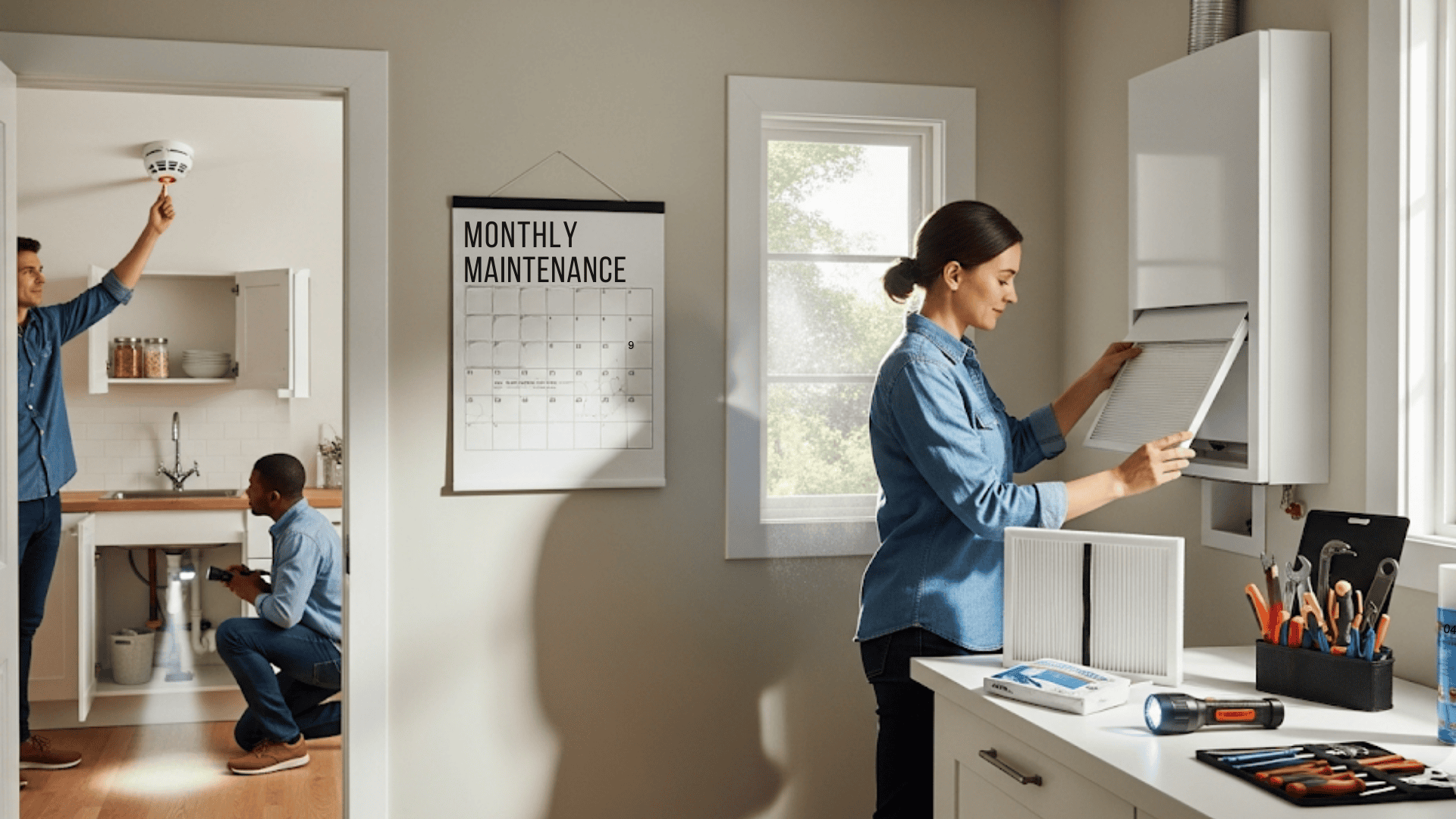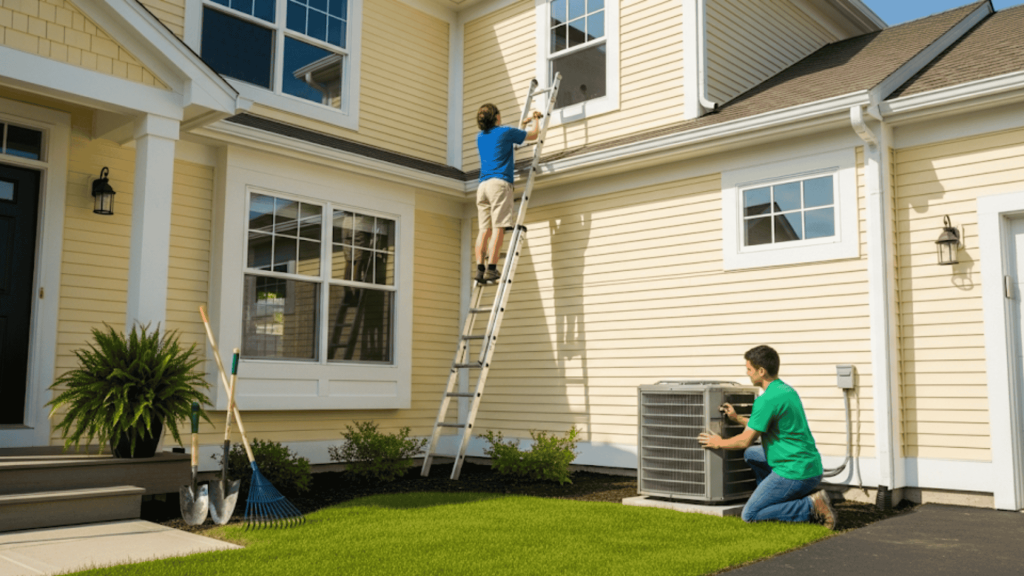Are you tired of facing sudden home repairs that could have been prevented? Most homeowners wait until something breaks before taking action.
This reactive approach often leads to expensive fixes and stressful situations. Regular home maintenance isn’t just about keeping your house looking good; it’s also about maintaining its value.
It’s about protecting your biggest investment and saving money in the long run. A small leak today can become a costly water damage issue tomorrow.
The good news? You don’t need to be a handyman to maintain your home properly. Most maintenance tasks are simple and can be done with basic tools.
In this blog, I’ll show you exactly how to create a home maintenance routine that prevents problems before they start.
Why Home Maintenance Matters?
Preventive maintenance saves money and stress. Regular upkeep prevents small issues from becoming major repairs. It also maintains your home’s value and keeps your family safe.
A well-maintained home uses less energy, resulting in lower utility bills. Insurance companies may offer discounts for homes with updated systems and regular maintenance records.
Most importantly, you avoid the stress of emergency repairs when systems fail unexpectedly.
Warning Signs That Need Immediate Attention
- Some problems can’t wait for your scheduled maintenance. Call professionals immediately if you notice:
- Electrical Issues: Flickering lights, burning smells, warm outlets, or breakers that trip repeatedly.
- Plumbing Emergencies: No water pressure, sewage odors, backed-up drains, or visible pipe leaks.
- Structural Concerns: Wall or foundation cracks, doors that won’t close, or sagging floors and ceilings.
Essential Tools for Home Maintenance
You don’t need a workshop full of tools. These basic items handle most maintenance tasks:
| Tool Category | Essential Items | Purpose |
|---|---|---|
| Hand Tools | Screwdriver set, Hammer, Pliers, and an Adjustable wrench | Basic repairs and adjustments |
| Power Tools | Cordless drill, Level, Measuring tape | Installation and precision work |
| Safety Equipment | Work gloves, Safety glasses, and a First aid kit | Personal protection |
| Cleaning Supplies | Rags, All-purpose cleaner, Bucket | General maintenance cleaning |
| Specialty Items | Flashlight, Non-slip ladder, Utility knife | Access and detailed work |
Seasonal Home Maintenance Schedule

Each season brings specific maintenance needs. Follow this schedule to stay ahead of problems.
1. Spring Maintenance Tasks
Clean gutters and downspouts thoroughly to remove winter debris. Inspect your roof for missing shingles, damaged flashing, or loose gutters from winter storms.
Service your air conditioning system before hot weather arrives to ensure it runs efficiently.
Check outdoor structures, such as decks and patios, for loose boards, cracks, or safety issues that may have developed over the winter.
2. Summer Maintenance Tasks
Deep clean outdoor furniture, grills, and patio areas to remove built-up dirt and prepare for heavy use.
Inspect and clean dryer vents to prevent fire hazards, as lint buildup tends to increase during the summer months.
Check caulking around windows and doors, replacing any cracked or missing sections to maintain energy efficiency. Test sprinkler systems and garden hoses for leaks or clogs before peak watering season.
3. Fall Maintenance Tasks
Clean gutters again after leaves fall to prevent ice dams and water damage during winter. Winterize outdoor water faucets by shutting off valves and draining pipes to prevent freezing.
Service your heating system with new filters and a professional inspection before cold weather begins. Seal gaps around pipes, cables, and vents where cold air might enter your home.
4. Winter Maintenance Tasks
Check for ice dams on your roof and remove snow buildup that could cause structural damage. Keep pathways clear of snow and ice for safety, using salt or sand on walkways.
Monitor indoor humidity levels to prevent condensation problems and mold growth in closed spaces. Inspect your basement regularly for cracks, moisture, or signs of freezing that could indicate serious problems.
Monthly Home Maintenance Tasks

Start with these essential monthly checks. These quick inspections take less than an hour but can save you thousands in repairs.
1. HVAC System Check
Change your air filters every 1 to 3 months. A dirty filter causes your system to work harder and increases your energy bills. Check the filter by holding it up to the light. If you can’t see through it clearly, it’s time for a replacement.
Pro tip: Buy filters in bulk and write the replacement date on each one.
2. Water System Inspection
Look for leaks under sinks, around toilets, and near your water heater. Check water pressure in all faucets and showerheads. Low pressure often means mineral buildup or a hidden leak.
Warning signs to watch for:
- Water stains on ceilings or walls
- Musty smells in bathrooms
- Higher than normal water bills
3. Safety Equipment Test
Test smoke detectors and carbon monoxide detectors monthly. Replace batteries twice a year, coinciding with daylight saving time changes. Check fire extinguisher pressure gauges and flashlight batteries.
How to Create Your Maintenance Schedule

Building a routine makes maintenance automatic. Here’s how to set up a system that works:
Step 1: List Your Home’s Features
Walk through your home and note:
- Number of HVAC filters needed
- Types of flooring that need care
- Appliances requiring regular service
- Outdoor features like decks or pools
Step 2: Use a Calendar System
Digital calendars work well because they send reminders. Set up recurring events for:
- Monthly filter changes
- Seasonal deep cleaning
- Annual professional inspections
Step 3: Keep Records
Keep track of what you’ve done and when. Note any problems you find. This history helps you spot patterns and plan future maintenance.
Step 4: Budget for Maintenance
Set aside 1-3% of your home’s value each year for maintenance and repairs. This prevents financial stress when larger projects arise.
Money-Saving Home Maintenance Tips

Smart maintenance saves money in two ways: preventing expensive repairs and improving energy efficiency.
Do It Yourself vs. Hire Professionals
- You can handle tasks such as changing air filters, cleaning gutters on single-story homes, caulking minor gaps, and performing basic paint touch-ups. These simple tasks require minimal skill but provide significant value when done regularly.
- Leave to professionals: Electrical work beyond changing bulbs, gas appliance repairs, roof work above ground level, and major plumbing issues. The cost of professional service is much less than fixing mistakes or dealing with safety hazards.
Energy-Saving Maintenance
- Seal air leaks: Use weatherstripping and caulk around windows and doors to reduce heating and cooling costs. This simple task can cut energy bills by 10-15% annually.
- Clean appliances: Keep refrigerator coils dust-free and dryer vents clear to improve efficiency. Regular cleaning can significantly extend appliance life and reduce energy consumption.
- Maintain HVAC: Change filters monthly and schedule annual tune-ups to keep systems running at peak efficiency. A well-maintained system uses 15-20% less energy than a neglected one.
Conclusion
A solid guide to home maintenance doesn’t have to be complicated.
Begin by conducting monthly checks of your HVAC, plumbing, and safety equipment. Follow seasonal schedules for deeper cleaning and preparation tasks.
Remember that small efforts now prevent big problems later. Changing a filter prevents expensive repairs. Regular maintenance protects your investment and keeps your family comfortable.
The key is consistency. Select a system that suits your schedule and adhere to it consistently. Your future self will thank you for avoiding emergency repairs and enjoying a safe home year-round.
What’s your biggest home maintenance challenge? Share your questions or tips in the comments below!





































